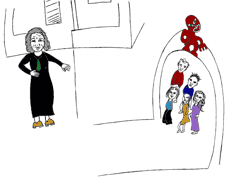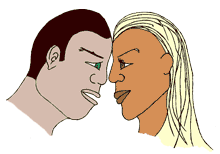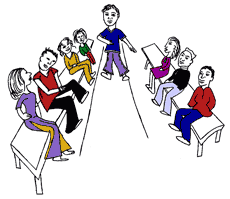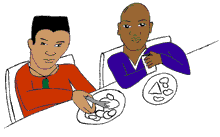The Pöwhiri
It is impossible to explore the full depth of a pöwhiri, or all the variations between iwi (tribal) groupings. This page focusses on the basic elements of the pöwhiri process.
All are welcome to add comments. Please go to Support and fill in the Feedback Form if you would like to share your whakaaro (thoughts), or clarify any points.
| What is a pöwhiri? | |
| When two groups want to gather on a marae, there is a pöwhiri, or welcome. This unites the groups under whatever kaupapa (purpose) they share. | |
| It is important to understand some background about what a marae is. Click on the Marae link to find out more. | |
| The key elements for a pöwhiri: | |
| Step 1 - Tängata - People | |
| The most important ingredient is people. Without people, there is no reason for the pöwhiri. Without people you would be unable to carry out a pöwhiri. The key to the pöwhiri process is recognising and allowing the balance needed between the different roles that people play in bringing together the two groups. | |
| Step 2 - Karakia - Prayer | |
| Not for religious reasons. Karakia is as important a part of the preparations by the manuhiri (visiting group) as organising the speakers, the songs and the köha, because it helps to: | |
|
|
| Step 3 - Wero - the challenge | |
| Once the manuhiri are waiting by the tomokanga (entrance/gate), a warrior is sent down to make sure the group are visiting with peaceful intentions. This was important traditionally as the manuhiri (visiting group) would not have organised anything prior to arriving. The tangata whenua (people of the marae) needed to find out if the manuhiri came in peace or for war. | |
| Step 4 - Karanga - the call | |
| The kaikaranga begins the spiritual welcome, by calling to the manuhiri, who respond in turn. This is usually done by women, as their voices have the ierere (wavelength) to call to the tupuna (ancestors) of the manuhiri and welcome them along with the living. |  |
This calling between the kaikaranga of the tangata whenua and the manuhiri acts as a:
|
|
| Step 5 - Haka Pöwhiri - the start of the physical welcome | |
| The tangata whenua chant a haka in unison. Through their voices, it is clear that the manuhiri can proceed to the paepae (seats). | |
|
|
| Step 6 - Whaikörero - Speeches of welcome | |
| The pöwhiri looks to the reasons for gathering. The tangata whenua and manuhiri take it in turns to express their hopes and needs for the gathering. | |
| Step 7 - Waiata Tautoko - Songs in support | |
| After each speaker finishes, their group stands to show support for what has been said. | |
| Step 8 - Köha - the gift | |
The reality today is the huge cost of running any kind of gathering. Traditional köha could have been any of the following :
|
|
| Step 9 - Hariru me te Hongi | |
| The final of the formalities, the hongi is a symbol of the sharing of breath or the unity of two people. |  |
| Step 10 - Te Hakari - The Feast | |
| The pöwhiri is a tapu (sacred) process, or one that should be respected. The sharing of food normalises the groups (returns them to a state of noa), who can then begin their shared kaupapa. | |
|
|









